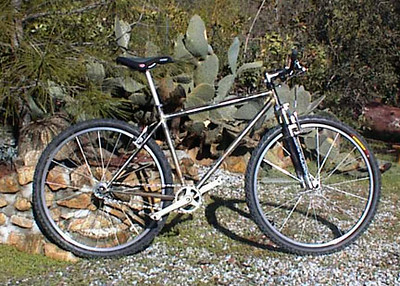Crankarm Chronicles Pt.1
These days crank arm length is a hot topic. I almost avoided it - I've been happily turning over 175s for 35 years and didn't see a need to change. I even did some experiments 20 years ago. But the topic wouldn't disappear, and in the middle of 2023 of course I got curious. So this series of posts covers what I thought I knew before and what I've discovered since then.
The first round
Let's go back, well, to the start. I started riding mountain bikes in late 80s, and mountain bikes came with 175mm long cranks. Being tall and living in an area with lots of climbing I ran 172.5 cranks on my road bike. All pretty normal stuff.
Jump ahead to the end of the Nineties. I had gotten hooked on single speed mountain bikes. There were many reasons - I worked in a bike shop and spent enough time wrenching on bikes that it was nice to have a bike that needed minimal maintenance. The racing scene was very DIY and punk rock so it had natural appeal. And there was something so nice and quite to not have a loose chain making a racket.

While I started out on 175s, the hot setup was to run longer cranks and after trying some 180mm cranks I was sold. It made sense - a longer crank means more leverage and climbing on a single speed is all about getting as much leverage as you can.
Fast forward a couple more years. Single speeds had blown up thanks to forums and blogging. But in the blogosphere sometimes singlespeeder Jeff Jones of Jones Bikes was blogging Doing some searching I found this post from Jones that talks about short cranks. I'd have to do some digging on MTBR to see the dates line up. about running 170 cranks or even 165s! At the time running "road" cranks sounded crazy but they were easier on his knees and he like the extra clearance.
Jones' short crank preference caught the eye of the online single speeders so the question "Why don't people run short cranks on single speeds?" naturally came up. The general physics of it all suggests it's all ratios, so if you drop your crank length you can drop your gear to keep the force the same. Your cadence then goes up a little to compensate. So it seemed like if you went from 180 to 170 you'd lose 5% leverage. If you drop your gear 5% to compensate then the force at the pedal would be the same. But in the distance you normally would do 20 turns of the pedal, you'd do 21. But the distance the pedal moves while you're pushing it would also be shorter, so it seemed like it would all average out.
So was there really a difference? I knew I liked longer cranks, but I couldn't say I had changed my gearing when I switched. It was interesting and easy enough to try. I had some 170s in the parts bin and I swapped out my cog and ring to about a 5% lower gear. There was also the question of adaptation - I had been riding 180s for years at that point so I expected it would take some time to adjust. I promised myself to give the short cranks a full year.
Well, that year sucked. Climbing was harder. Race placings dropped. The physics should have been the same but it seemed like the physiology wasn't.
It wasn't a factor of more force on the legs, so what made it harder? My conclusion was that while you had to do more pedal rotations, even if each pedal stroke was shorter it still meant you had to do more core work stabilizing from one power stroke to the other. This work was more isometric, bracing against the same force, so it would end up being the same. That work added up and in the end wasted extra energy.
The 170s weren't all bad. On flats, especially out of corners, they seemed to "rev up" faster. But they were shorter and should be easier to spin so I assumed that was all that was going on there. Since singlespeeds were mostly about climbing I put the 180s back on and they stayed there.
When I left the mountains for the plains, I was mostly riding my cyclocross bike on flat gravel roads, where my usual 175s were fine. I couldn't see any reason to ride anything else.
Then I moved back to the mountains which meant mountain bikes were back on the menu. I had lost all my single speed strength spinning circles in the wind, so I stuck to geared bikes and 175s. But short cranks were starting to get some discussion as having some real strengths. Off road the increased pedal clearance was a good match for new progressive MTB geometries with lower bottom brackets. From the triathlon world riders were using short cranks to get a flatter back.
My framebuilding output got a nice jump and a new hardtail needed some cranks. The only extra ones I had were 170s from my wife's bike, so I thought I'd give them a try. I felt slower climbing, like something was missing.
I was still riding cyclocr... I mean gravel bikes, and the wind here could be worse than the plains, so I was thinking trying to get a smaller position to beat the wind a little. Again, I gave the 170s a try, and again, something about them just felt wrong. It was the old experiment all over again it seemed. My only conclusion was that, like everyone said, 175s were the right size for someone my height.
As the title hints, this is part 1 and the story continues...
Tags: #cranks Categories: #Crankarm Chronicles